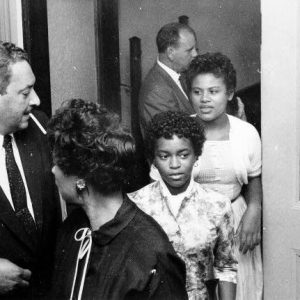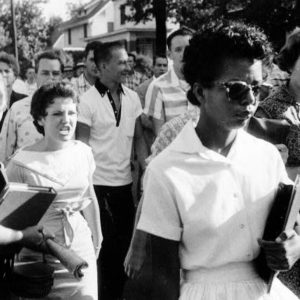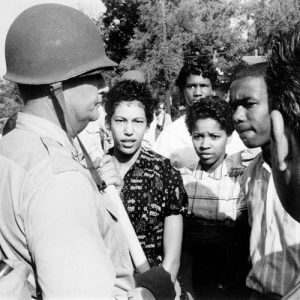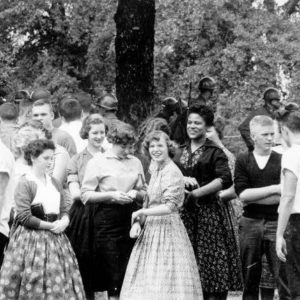calsfoundation@cals.org
Will Counts (1931–2001)
aka: Ira Wilmer Counts
Ira Wilmer (Will) Counts Jr. was a photographer best known in Arkansas for his photographs during the 1957 desegregation of Central High School in Little Rock (Pulaski County). His photographs have been widely recognized as among the most memorable of the twentieth century.
Will Counts was born on August 24, 1931, in Little Rock to Ira Counts Sr. and Jeanne Frances Adams Counts; he had one brother. The Counts family sharecropped near Rose Bud (White County) and then outside Cabot (Lonoke County) before moving in 1936 to the Resettlement Administration’s Plum Bayou Homestead in Jefferson County. When the family moved back to Little Rock, where Counts attended Little Rock High School (later Central High), he developed his initial interest in photography with help from Edna Middlebrook, a journalism teacher at the school.
Photography had not interested him until his junior year, when he saw an advertisement for a Speed Graphic camera in Boys’ Life magazine. He asked his mother for one as a Christmas present, but, with his father overseas fighting in World War II, she could only afford a Kodak Brownie Hawkeye.
In 1949, Counts entered Arkansas State Teachers College (now the University of Central Arkansas) and helped pay his way by working as the school’s photographer and as a freelance shooter for the Arkansas Gazette and the Arkansas Democrat. He received a BA in education in 1952. After earning his master’s degree in education in 1954 at Indiana University (IU) in Bloomington, Indiana, he worked briefly as a photographer at the Arkansas Democrat and then at the IU audiovisual center. In June 1957, he was rehired at the Democrat as a staff photographer for its Sunday Magazine.
Counts’s first powerful images of the Central High School desegregation crisis appeared on September 4, 1957. The most recognizable photo is that of Elizabeth Eckford being harassed by white students in the front of the school. In his 1999 book about the crisis, A Life Is More Than a Moment, Counts explains that he wore a red plaid shirt while shooting at Central to avoid looking like an “Eastern Establishment” journalist. His book also reveals that using a 35mm Nikon S2 camera with a wide-angled lens gave him a significant technical advantage over the other photographers, who were shooting with large Speed Graphic press cameras that required reloading after each shot. Counts was able to shoot thirty-six exposures before reloading and was thereby able to follow the example of his idol, French photographer Henri Cartier-Bresson, who believed that shooting many exposures would increase the chances of getting the best representative shot of an event. In 1997, Counts and his wife, Vivian, successfully organized a reconciliation between Eckford and Hazel Bryan Massery, the young white student pictured screaming at Eckford in the now infamous photo.
The Pulitzer jury for photography unanimously recommended Counts for a Pulitzer Prize in 1957, but the board overruled the jury, possibly reasoning that four prizes for coverage of a single event would be too many. Two Pulitzers that year went to the Arkansas Gazette, and another to an Associated Press reporter for the Central High story. But Counts’s photograph of journalist Alex Wilson being beaten, harassed, and kicked took first place in the spot news category of the fifteenth annual “News Picture of the Year Competition,” then sponsored by the National Press Photographers Association, Encyclopedia Britannica, and the University of Missouri School of Journalism. It was also selected by Encyclopedia Britannica as one of the world’s fifty most memorable news pictures of the last fifty years. It was said President Dwight D. Eisenhower ordered federal troops to the school after seeing the photo.
Following photojournalist positions at the Associated Press in Chicago, Illinois, and Indianapolis, Indiana, Counts earned his doctorate in education at IU in 1967, having joined the faculty in 1963. He then helped develop one of the best-regarded photojournalism departments in the country. He was inducted into the Indiana Journalism Hall of Fame in 1996.
In addition to his book on Central High, Counts authored three other books: A Photographic Legacy (1979), which updates rural Arkansas scenes shot by Farm Security Administration photographers such as Ben Shahn and Walker Evans in the 1930s; The Magnificent 92: Indiana’s Courthouses (1991), which features Counts’s photographs of every county courthouse in Indiana; and Monroe County in Focus (1993), which includes many photos from that Indiana county. He also co-authored Bloomington: Past and Present (2002).
Counts retired from Indiana University in 1995. He died on October 6, 2001, of cancer.
For additional information:
Counts, Will. A Life Is More Than a Moment: The Desegregation of Little Rock’s Central High. Bloomington: Indiana University Press, 1999.
“I. Wilmer Counts.” Indiana Journalism Hall of Fame. https://ijhf.org/members/1996/i-wilmer-counts (accessed February 28, 2007).
Anne Gochenour
Arkansas Arts Center
Staff of the CALS Encyclopedia of Arkansas
 Central High Students Leaving Federal Court, 1957
Central High Students Leaving Federal Court, 1957  Elizabeth Eckford Denied Entrance to Central High
Elizabeth Eckford Denied Entrance to Central High  National Guardsman Confronts Students at Central High
National Guardsman Confronts Students at Central High  Minnijean Brown with Classmates
Minnijean Brown with Classmates 




Comments
No comments on this entry yet.